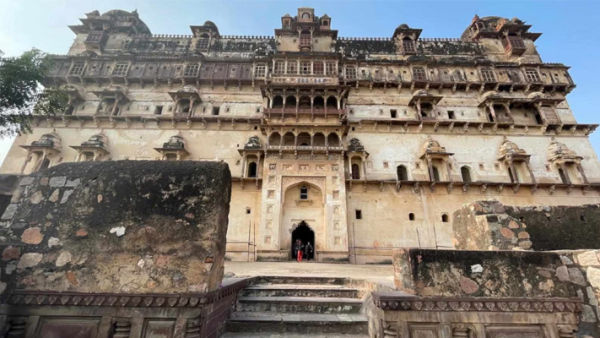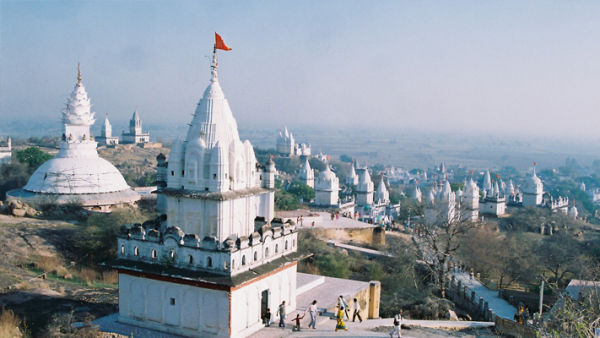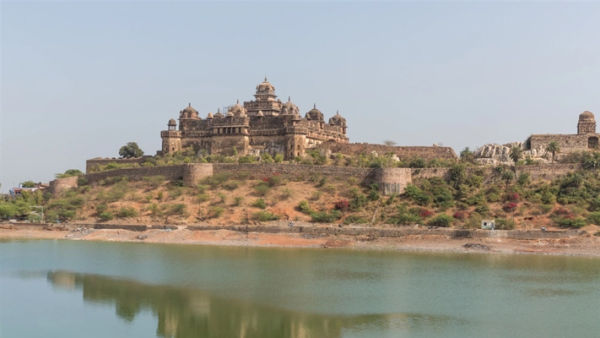
Datia Palace, also known as Bir Singh Palace, is a historical fort and palace complex located in the city of Datia in the Indian state of Madhya Pradesh. The palace holds significant historical and architectural importance, and it showcases the grandeur and splendor of the Bundela Rajput dynasty, which ruled the region during the medieval period. This majestic palace complex stands as a testament to the opulence and architectural brilliance of the Bundela Rajput dynasty that once ruled this region. With its captivating blend of Rajput and Mughal architectural styles, Datia Palace exudes an air of regal grandeur, inviting visitors to step back in time and immerse themselves in the rich history and cultural heritage of India's medieval past. From ornate carvings to splendid frescoes, every corner of this royal abode echoes the artistic prowess of a bygone era. Join us on a journey through time as we explore the captivating allure and timeless elegance of Datia Palace.


Overview
Architectural Style: Datia Palace is a fine example of Rajput architecture, characterized by its imposing structure, intricate carvings, and beautiful frescoes. The palace reflects a blend of Rajput and Mughal architectural influences, which adds to its unique charm.
History: The construction of Datia Palace dates back to the early 17th century when it was built by King Bir Singh Deo, a prominent ruler of the Bundela dynasty. The palace served as a royal residence and a stronghold during times of warfare.
Design and Layout: The palace complex comprises several courtyards, palatial buildings, pavilions, and gardens. It was strategically designed to offer a defensive advantage, with high walls and watchtowers.
Art and Decorations: Datia Palace is adorned with exquisite paintings, ornate ceilings, and delicate carvings that showcase the artistic prowess of the artisans of that era. The interiors feature beautiful murals and frescoes, depicting various mythological themes and scenes from royal life.
Ganesha Temple: Within the palace complex, there is a notable temple dedicated to Lord Ganesha, which is revered by both locals and visitors.
Surroundings: The palace is situated atop a hill, offering panoramic views of the surrounding landscape and the town of Datia. The scenic beauty and peaceful ambiance make it a captivating destination for history enthusiasts and architecture lovers.
Visitor Experiences and Activities Enjoyed
Visitors to Datia Palace can indulge in a range of enriching experiences and activities, each offering a glimpse into the region's history and architectural splendor. Here are some of the top visitor experiences and activities enjoyed at Datia Palace:
Heritage Tour: Embark on a guided heritage tour of Datia Palace to learn about its fascinating history, architectural features, and the lives of the Bundela rulers who once inhabited this majestic complex.
Exploring the Palace Complex: Wander through the intricately designed courtyards, pavilions, and halls within the palace complex. Admire the exquisite carvings, splendid frescoes, and artistic details that adorn the walls and ceilings.
Photography: Photography enthusiasts will find ample opportunities to capture the beauty and grandeur of Datia Palace. The stunning architecture and scenic surroundings make it a paradise for capturing captivating shots.
Ganesha Temple Visit: Pay a visit to the Ganesha Temple within the palace complex. This ancient temple holds religious significance and is a place of reverence for both locals and visitors.
Enjoying Scenic Views: Take in the panoramic views of the surrounding landscape from the vantage points within the palace. The hilltop location offers breathtaking vistas of Datia town and its serene surroundings.
Picnicking and Relaxation: The palace gardens provide a tranquil setting for picnicking and relaxation. Enjoy a leisurely afternoon amidst the historical ambiance and natural beauty of the palace grounds.
Cultural Events and Festivals: Depending on the time of your visit, you may have the opportunity to witness cultural events or festivals held at the palace. These celebrations offer a glimpse into the local traditions and add vibrancy to the historical setting.
Exploring Datia Town: Take a stroll through the charming streets of Datia town to experience its local culture, traditional markets, and interact with the friendly locals.
Learning Local Legends: Engage with local guides or residents to hear captivating tales and legends associated with Datia Palace and the Bundela dynasty, adding a touch of storytelling to your visit.
Shopping for Souvenirs: Don't miss the chance to shop for souvenirs and handicrafts in the town, including traditional textiles, artifacts, and other locally produced items.


Other Top Attractions Nearby
In addition to Datia Palace, there are several other top attractions and places of interest located nearby, offering visitors a chance to explore the rich cultural and historical heritage of the region. Here are some of the top attractions worth visiting:
Sonagiri Jain Temple: Situated approximately 15 kilometers from Datia, Sonagiri is a revered Jain pilgrimage site. It is home to a cluster of stunning white marble temples perched on a hilltop, dedicated to the 10th Tirthankara, Chandraprabhu. The temples' serene atmosphere and intricate architecture make it a significant spiritual destination.
Pitambara Peeth: Located in Datia town itself, Pitambara Peeth is a prominent Hindu temple dedicated to Goddess Baglamukhi, considered to be one of the Mahavidyas. The temple's striking architecture and spiritual significance attract devotees from across the country.
Bir Singh Palace Museum: Inside Datia Palace, there is a small museum displaying artifacts, historical relics, and artworks from the Bundela era. It offers visitors further insights into the region's history and the lives of its rulers.
Gujari Mahal Archaeological Museum: Situated in Gwalior, approximately 74 kilometers from Datia, this museum houses a vast collection of sculptures, artifacts, and antiques, providing a glimpse into the rich cultural heritage of the region.
Sikander Mahal: Also located in Gwalior, Sikander Mahal is a splendid palace with remarkable architectural features. The palace is a part of the larger Gwalior Fort complex and is famous for its artistic beauty and historical significance.
Gwalior Fort: This ancient hill fort, situated in Gwalior, is one of the most iconic monuments in Madhya Pradesh. With its massive walls, palaces, temples, and water tanks, the fort offers a captivating journey through history.
Jai Vilas Palace: Another gem in Gwalior, Jai Vilas Palace is an opulent 19th-century palace, showcasing a blend of European and Indian architectural styles. It is renowned for its exquisite architecture, collection of antiques, and the world's largest chandelier.
Tansen Tomb: Located in Gwalior, the Tansen Tomb is the resting place of Tansen, one of the most renowned classical musicians in the Mughal court. The tomb's architecture reflects the blend of Mughal and Hindu styles.
Chanderi Fort and Temples: Chanderi, around 65 kilometers from Datia, is famous for its historical forts, palaces, and ancient temples. The town's rich cultural heritage and scenic beauty make it an enticing destination.
Shivpuri: About 70 kilometers from Datia, Shivpuri is known for its tranquil lakes, lush forests, and the historic Bhadaiya Kund, where the King of Gwalior used to perform a water conservation ritual.
Interesting Facts
Palace of Seven Stories: Datia Palace is often referred to as the "Palace of Seven Stories" due to its unique architectural design, with several levels that offer commanding views of the surrounding landscape.
Blend of Architectural Styles: The architecture of Datia Palace showcases a captivating fusion of Rajput and Mughal styles, making it a distinctive example of cultural amalgamation during the medieval era.
Bir Singh's Unique Contribution: The palace was commissioned by King Bir Singh Deo, the ruler of the Bundela Rajput dynasty, who is credited with various architectural and cultural contributions in the region.
Mural Paintings: The palace's interiors are adorned with remarkable mural paintings that depict scenes from ancient mythology, historical events, and daily life during the time of the Bundela rulers.
Spiritual Significance: Datia town is considered a sacred place by many due to the presence of several religious sites, including the Ganesha Temple within Datia Palace and the Pitambara Peeth dedicated to Goddess Baglamukhi.
Sonagiri Jain Temples: The Sonagiri Jain Temple complex near Datia is renowned for its 77 white marble temples, each representing one of the "Moksha Tirtha" or spiritual destinations for Jain pilgrims.
Historical Significance of Datia: Datia was once a princely state under British India, and it played a significant role during the Indian Rebellion of 1857 (also known as the Sepoy Mutiny) as one of the major centers of rebellion.
Gujari Mahal Museum: The Gujari Mahal Museum in Gwalior houses the famous "Gwalior Manuscript," an ancient Sanskrit text that provides valuable insights into Indian classical music and dance.
Tomb of Tansen: The tomb of Tansen, the legendary musician and one of the "nine gems" of Akbar's court, is a renowned landmark in Gwalior and a pilgrimage site for music enthusiasts.
Gwalior Fort's Musical Legacy: The Gwalior Fort has a rich musical history and is believed to be the birthplace of the Gwalior Gharana, one of the oldest and most prominent schools of classical Indian music.
Best Time to Visit
The best time to visit Datia Palace is during the winter months, from October to February. During this period, the weather in Datia is pleasant and comfortable for exploration. The daytime temperatures range from around 10°C to 25°C (50°F to 77°F), making it ideal for sightseeing and outdoor activities. The cool evenings create a delightful ambiance for exploring the palace complex, with its captivating architecture and historical charm. Additionally, the winter season brings minimal rainfall, ensuring a hassle-free travel experience. Embrace the pleasant weather and immerse yourself in the regal splendor of Datia Palace during this enchanting time of the year.


How to Reach
Datia is well-connected by road and train, making it easily accessible from various parts of India. Here are the main transportation options to reach Datia:
By Train: Datia has its own railway station, known as Datia Railway Station and is well-connected to major cities in India, including Delhi, Agra, Gwalior, Bhopal, and Jhansi.
By Road: Datia is well-connected by road and can be accessed via national and state highways. The city is situated on the National Highway 75 and there are regular bus services from nearby cities and towns to Datia.
By Air: The nearest airport to Datia is the Gwalior Airport (about 80 kilometers away), which has domestic flight connections to major cities like Delhi and Mumbai. From the airport, you can hire a taxi or take a bus to reach Datia.
From Delhi: To reach Datia from Delhi, you can opt for a train journey, as there are several direct trains connecting Delhi to Datia. Alternatively, you can drive or take a bus to Datia, which is approximately 420 kilometers from Delhi.
From Gwalior: If you are coming from Gwalior, you can take a direct train to Datia or travel by road, which is approximately 75 kilometers.
From Jhansi: Datia is around 40 kilometers from Jhansi, and you can reach it by road in about an hour or take a direct train from Jhansi to Datia.





